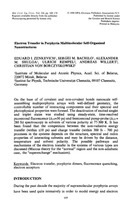| dc.contributor.author | Zenkevich, E. I. | en |
| dc.contributor.author | Bachilo, S. M. | en |
| dc.contributor.author | Shulga, A. M. | en |
| dc.contributor.author | Rempel, U. | en |
| dc.contributor.author | Willert, A. | en |
| dc.contributor.author | Borczyskowski, C. von | en |
| dc.date.accessioned | 2017-05-25T09:58:04Z | |
| dc.date.available | 2017-05-25T09:58:04Z | |
| dc.date.issued | 1998 | |
| dc.identifier.citation | Electron transfer in porphyrin multimolecular self-organized nanostructures / E. I. Zenkevich [et al.] // Molecular Crystals and Liquid Crystals. – 1998. – Vol. 324. – P. 169-176. | en |
| dc.identifier.uri | https://rep.bntu.by/handle/data/30135 | |
| dc.description.abstract | On the base of of covalent and non-covalent bonds nanoscale self-assembling multiporphyrin arrays with well-defined geometry, the controllable number of interacting components and their spectral and photophysical properties were formed. The deactivation of excited singlet and triplet states was studied using steady-state, time-resolved picosecond fluorescence (∆½≈30 ps) and femtosecond pump-probe (∆½≈280 fs) spectroscopy in solvents of various polarity at 77-300 K. It has been found that the competition between the non-radiative energy transfer (within ≤10 ps) and charge transfer (within 300 fs - 700 ps) processes in the systems depends on the structure, spectral and redox properties of interacting subunits and may be driven by the distance, temperature and solvent polarity. The possible pathways and mechanisms of the electron transfer in the systems of various types are discussed (Marcus theory for the “normal” region and the non-adiabatic case, the “superexchange” mechanism). | en |
| dc.language.iso | en_US | e |
| dc.title | Electron transfer in porphyrin multimolecular self-organized nanostructures | en |
| dc.type | Article | ru |
| dc.identifier.doi | 10.1080/10587259808047151 | |

